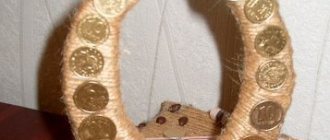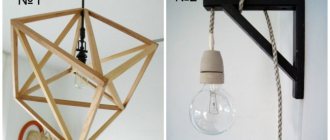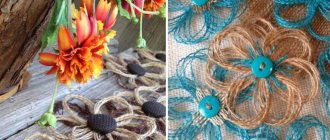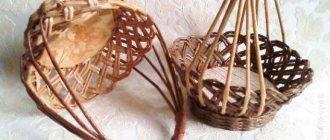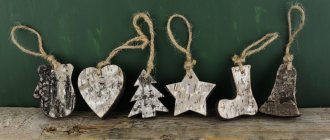Original chandeliers with an unusual design are now in fashion. Such a decorative detail can become a special element of the harmonious appearance of any room. Many manufacturers offer to purchase original and bright solutions in various styles, however, you can make an excellent lampshade yourself from quite familiar scrap materials.
Today we will figure out how to make an unusual rope chandelier .
Necessary materials for making a chandelier with your own hands:
- clothesline;
- It is better that it is thicker;
- glue: regular PVA and for decoupage, for example, Mod Podge;
- white spray paint;
- wooden plank;
- scotch;
- round lampshade as a base.
In addition, we need a small ball or ball. A simple inflatable beach volleyball ball will do.
The rope should be about 10 m, it is best to use light shades, in particular white. Also, make sure that the PVA glue you use is thick enough.
We also need a strip or plinth with a smooth recess in order to lay the rope there and give it a stylish wave-like shape. After placing the rope in such a retainer, it must be thoroughly coated with glue and dried for 24 hours until the new form is completely fixed.
Now we take our ball and glue it tightly with pieces of electrical tape or adhesive tape. This is necessary so that the rope does not subsequently lose its even twisted shape. Next, we lay the rope evenly over the round surface, slowly moving along a correctly spiral-shaped path. At the same time, we thickly coat the entire structure with our decoupage glue.
We separate the base-shade from the old chandelier. It should more or less match the style of the intended product.
We paint with white spray paint, spraying it evenly over the surface. We should get a frozen hemisphere of a rich white shade.
We assemble the entire product, connecting the base with our hemisphere.
Such a seemingly inconspicuous material like clothesline can turn out to be a chic option for decorative finishing in many other corners of your apartment. So, as you can see, making such an interesting little thing is quite simple, the main thing is to offer a little effort and skill. A beautiful DIY rope chandelier will be an excellent addition to the interior of any room.
In principle, this way you can decorate not only a chandelier, but also a floor lamp, sconce, table lamp or just a decorative item. The lampshade is perfect for a minimalist and rustic style.
All you need is a balloon (if you want an even round shape, an inflatable ball from the sporting goods section is better), a roll of natural hemp twine (at least 100 meters, depending on the diameter of the ball), a permanent marker, disposable gloves, quick-drying glue and scissors.
Advantages of using a thread lampshade
The interweaving threads of the lampshade will create fancy shadows on the walls, drawing intricate laces that will tremble and sway from the slightest draft in the room. Warm, calm light will sprinkle small rays and draw smiles on the wallpaper and ceiling. Lightness and weightlessness, the measured swaying of the lamp will give peace and quiet joy, which is akin to light meditation on the shore of a warm, gentle sea.
Look through your yarn baskets and find threads that match the color and texture to match the color scheme of the room. Then your creation will live in a single ensemble with a common atmosphere, and complement and decorate the interior of the room.
Thread to thread, circle by circle... And before your eyes a unique pattern of colored yarn will be born. And you won’t be able to create a second work like this; each thread lampshade will be special and unique. Turn on the music, free your mind from unpleasant thoughts and immerse yourself in the meditative process...
How to make a frame for a lampshade
In old table lamps, the frame usually does not undergo such irreversible changes and deformations that it cannot be used to create a new lampshade. But a person may not be satisfied with its shape or size, and then he has to make a new one with his own hands. The question is: how and from what?
The easiest way is to use aluminum or steel wire of such a cross-section that it holds its shape well. The skeleton of the future lampshade is formed from it.
| Stages of work | Description |
Stage 1 | We cut out templates from cardboard for all lampshade diameters. It can be one if the shape is assumed to be cylindrical, two if it is cone-shaped, three or more if it is complex. We cut off pieces of wire and form circles from it according to the template. Twist the ends tightly, using pliers if necessary. |
Stage 2 | We decide on the height of the lampshade and the number of vertical jumpers. We cut the wire for them 8-10 centimeters longer than needed. |
Stage 3 | We bend the excess ends of the wire perpendicularly and wrap them around the upper and lower circle. We additionally fix all joints and mask them with electrical tape. You can wrap it around the entire frame. |
Stage 4 | If the lamp does not have a stop for the socket, we modify the frame. Why do we first make a wire ring with a diameter slightly larger than the diameter of the cartridge and connect it to the frame posts with horizontal jumpers. |
The frame can also be assembled by welding or soldering. When soldering, it is better to use soldering acid instead of rosin.
Advice. Ready-made items can also become the basis for a lampshade. For example, plastic or metal wire waste baskets, wicker vases or plastic bottles. They just need to cut a hole for the cartridge.
Tools and materials for work
In every home you can find almost all the elements to create such a lampshade:
- For the basic shape of the chandelier, you can choose an inflatable balloon, a small ball or the frame of an old chandelier or sconce, you can also use an embroidery hoop.
- Cotton, linen, wool or mixed threads. White balls made of cotton threads look ideal, this is a win-win option. Choose yarn that matches the main colors of the walls and wallpaper, maybe 2-3 shades darker or lighter. And if you or your children love holidays, then choose bright, rich colors in contrast to the main color.
- Glue (PVA, transparent stationery) and varnish for covering a ball of thread.
- For the electrical part you need a cartridge and a stranded wire 15-20 cm long
- If you want to make a wall sconce, then to work you will need a stand for the sphere, a wire with a plug and a light switch. Consider the lampshade option before starting work.
- If you choose to make a pendant from several small balls, then purchase or take out a garland with light bulbs from the New Year's box.
Assembling the lamp: step-by-step instructions
Once the lampshade is ready, assembling and hanging the lamp is not difficult. We do the following step by step:
- Pull the lamp socket through the hole.
- Pass the fishing line along the edges of the hole for the lamp with the socket and tighten it to the diameter of the socket.
- Check that the lampshade is securely attached to the socket.
- Hang it from the ceiling, connecting the phase, grounding, and neutral wire.
- Connect the wires to the floor lamp if we are talking about a floor or table chandelier.
Now let's check how it works. We flip the switch and see if everything was done correctly. You can buy the necessary set in the store - a wire, a socket and a plug for a socket, which are already connected together.
If stranded wires are connected, the conductor insulation should be cleared by about 4 cm. Each conductor is untwisted by 2 cm. If you have a soldering iron, the wires can be connected by soldering. The wires must be tinned before connecting.
DIY thread chandelier
- We inflate the balloon to the size we need and tie it well with thread. If it deflates, the shape of the lampshade will be sloppy and loose.
- Apply Vaseline or baby cream to the ball. This is done so that the adhesive threads come away from the ball well at the end of the work.
- On the top of the ball (where the tie is), carefully draw a circle with a felt-tip pen with a diameter of 5-7 cm, depending on the size of the lampshade. You can put the glass down and circle it.
- We need to soak the entire thread with glue. To do this, take a plastic cup and make two holes near the base, corresponding to the thickness of the yarn. Pull the end of the thread through the holes.
- Pour glue into a glass. We attach a bobbin of wool or a spool of thread to a pin so that the ball does not roll away during work. Carefully pull the yarn through the cup of glue.
- The creative part begins. We wind the thread evenly around the ball, trying not to make large gaps (unless this is part of your idea). Leave the chuck surface open. Let the ball dry for several hours. You can hang the lampshade by a thread, or put it in a pan so that the shape does not wrinkle.
- After the ball is dry, pierce it with a needle, or release the air from it and remove it from the inner sphere.
If desired, you can coat the lampshade with furniture varnish, this will give it rigidity and shine.
Description of work
In order to end up with a beautiful rope lamp, you need to follow the following step-by-step instructions:
Ball with mark
- Cover the work surface with newspaper. Otherwise, you will have to clean it of glue residue;
- inflate a balloon or ball. It is better to use an inflatable balloon, as it is cheap and you won’t mind piercing it. You can use a special pump to inflate the ball. With it, work will speed up significantly;
Note! The size of the inflated balloon should correspond to the size of the intended lighting fixture.
- Next, draw a round hole on the ball using a felt-tip pen or marker. For a ball with a diameter of 40 cm, the hole drawn should be 10 cm in diameter. Through this hole you will later insert a socket with a light bulb. Those. the hole will mark the bottom of the future lighting fixture. Through this hole, the light from the bulb can be scattered throughout the room;
- to get a perfectly round hole, you can use, for example, a saucer or any other round product;
- We put rubber gloves on our hands;
- pour glue into the prepared container. A plastic bottle with a cut off neck can act as a container;
- moisten the prepared rope in glue;
Wetting the rope
- to make it easier to wet the rope, wrap it around your hand and slowly lower it into the glue;
- when it is completely soaked, carefully pull out the rope and remove excess glue using your fingers;
- Wrap the previously prepared ball with the resulting rope. At this stage you need to be very careful not to wrap the drawn circle;
Wrapped Ball
- It is worth wrapping until you are satisfied with the result. If you want to get a lamp with bright light, then we do not wind the rope very tightly. For dim lighting, it is necessary to wind the rope more densely with minimal gaps between the turns;
- should be wrapped randomly. In this case, the more disorder, the more beautiful. You can even try to lay out a specific pattern or design. But this will be quite difficult to do;
- the ends of the rope must be hidden very well;
- After this, our ropes should be completely dry. This will take approximately 24-48 hours;
- after complete drying, pierce the ball with a pin or needle;
- Carefully remove the remaining balls from the resulting ball. Be careful, if you do not act carefully, you can break the resulting structure.
The master class does not end there, since the resulting product must be additionally painted with latex paint.
Assembling the electrical part:
If you have an old lamp, then the task is simplified: take all the components and parts from it. But if it is not there, our instructions will help.
Let's prepare a set of materials:
- socket for an electric lamp;
- cartridge holder;
- the wire.
You can assemble such a structure yourself.
- We cut a hole in the center of the plastic cover to the size of the cartridge. It is advisable to take a cartridge with external threads and clamping rings. Secure the rings at the top and bottom of the lid.
- We attach the cover with the cartridge to the lampshade.
- We connect the wire from the cartridge contacts to the ceiling terminal.
If you want to make a sconce, table lamp or night light, then connect the wire through the switch to the plug for the electrical outlet.
Painting
Painting the lampshade
You only need to paint a DIY lamp with latex paint, as it is non-toxic and odorless. We dilute the paint of the desired color in a container and lower the ball into it several times. Hold it in the paint for about 3-4 seconds.
It is possible to decorate the resulting lamp using applique, beads and needlework. This will make the lighting fixture even more beautiful. Then simply insert the socket with the light bulb. Anyone can make a rope lamp with their own hands. Using this method, you can make a sconce or ceiling chandelier consisting of several shades. Moreover, they can have different colors. For all this you need a minimum set of materials and desire.
Lampshade made of threads on an old chandelier frame
An old lampshade will do the job. It is necessary to remove the old decorative material, correct the shape of the frame if it is deformed, and wind threads of the desired color, thickness and quality.
To make your work look neat, wind the threads evenly covering the area. You can place the yarn randomly, or you can lay the turns diagonally or perpendicular to each other. Thanks to this, beautiful intricate patterns will be created, and they, in turn, will cast fancy shadows on the walls and ceiling.
You don’t have to use glue in this option, but after finishing the work you will need to apply varnish to all layers of thread. Next, dry the frame well for 8 hours.
Manufacturing instructions
The instructions include a step-by-step description of the process of making chandelier shades. All points must be strictly followed to avoid unpleasant situations.
Lamp in the form of a sphere
The lampshade for a chandelier in the form of a sphere is universal. It won't be difficult to do it.
- Select a round plastic bottle of the required size.
- Cover the surface of the bottle with cream or Vaseline.
- Preparation of glue: glue is diluted with water in a ratio of 3:1.
- Preparation of the thread: a skein of thread is placed in the jar and covered with a layer of glue, a hole is made in the plastic lid with a needle and the thread is pulled through (the thread will pass through the hole, thereby getting rid of excess glue).
- Gradually the thread is removed from the jar and wound around the bottle (winding starts from the neck of the bottle).
- After complete winding, all layers are re-impregnated with glue. Spreading is done with a wide brush.
- Now we need to wait for it to dry completely. This will take at least 8-10 hours. The time also depends on the wound layer. If a thick layer is made, it is better to wait a day.
- Cut the ball exactly down the middle. You will get two hemispheres.
- The bottle is removed, and the hemispheres are connected with adhesive decorative tape. For reliability, before applying the tape, you can sew it with thread.
- The lampshade is ready.
If necessary, it can be covered with a layer of shiny paint or decorated with various decorative components.
Then the electrical part is assembled and all elements are fastened.
Cone lampshade
Shades of different shapes are made for the chandelier. A conical shape is often found. The principle of operation is similar to the previous ones, but the difference is in the thread winding pattern. In addition, it should be very tight; you can use a tourniquet.
- The surface of a 1.5-2 liter plastic bottle is covered with Vaseline.
- The glue is diluted with water (3:1).
- A jar of yarn and glue is prepared.
- The winding begins: the thread is fixed on the neck of the bottle, it must be wound clockwise, each subsequent layer lies tightly to the previous one.
- Winding occurs until the middle of the bottle. Next, the thread is cut and fixed.
- The top of the yarn is covered with glue.
- Wait until completely dry.
- Remove the resulting lampshade from the bottle.
- The product is ready.
Useful tips for choosing lamps
Be careful when choosing lamps for lampshades made of threads, since glue, varnish, and threads are flammable materials. They should be kept away from sources of high temperatures and open flames. Therefore, discard the old model incandescent lamp and opt for a fluorescent or LED lamp. They heat up slightly and consume less electricity, and their lighting intensity is higher.
The retail chain has a large selection of LED lamps, both in size and current consumption. A 9 W lamp produces the same light intensity as a 60 W incandescent lamp. They cost more, but with long-term use the savings on energy consumption are obvious. And the most important advantage is that the risk of fire is reduced.
Very often our taste preferences do not find options when choosing chandeliers, lamps or sconces in stores. In this case, you can create an interesting interior object with your own hands, using the proposed ideas and tips.
Interesting solution
Product in the interior
A light fixture made from rope can change the focus of any room. Using simple materials such as rope and glue, you can very quickly make a chandelier, a sconce, or even a lampshade for a floor lamp with your own hands. And the good thing about such a lighting device is that it can be used in many modern styles of decorating the interior space of a room. The rope lamp will fit perfectly into classic, country, Provence, etc. styles.
Such a lamp can not only fit harmoniously into the existing space, but also improve the mood of the apartment residents. The big advantage of this craft is the minimum amount of money and time spent.
